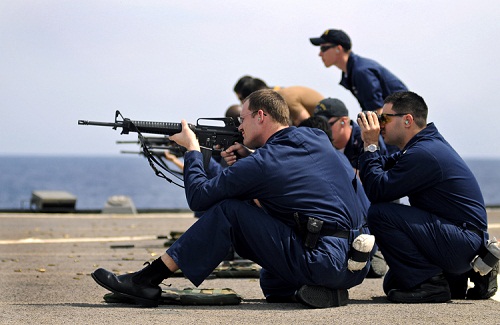The news media has recently portrayed assault rifles as an evil of society. However, the assault rifle is often a misunderstood device. The M16, the standard assault rifle used by the United States military and many other defensive forces throughout the world, derives its popularity from its durability, efficiency, accuracy, and variable fire rate. The firing mechanism provides the user with the option to fire a single round, three rounds, unlimited rounds, or none at all. Many principles of physics are involved in the operation of the M16, including the dissipation of heat, the mechanics of the trigger assembly, and the feeding of the magazine. This article covers some of the basic design principles of the M16, describes how it works, and briefly explains its origins.
Introduction
The east coast sniper attacks of October 2002 sparked national apprehension of the gunman’s weapon, a Bushmaster .223 caliber assault rifle. However, a well-known, military version of the assault rifle, the M16, has provided American soldiers with a precise and efficient weapon to protect the freedom of US citizens. Many engineering principles are endemic to the M16 rifle.
Creation
In 1954, the Armalite Division of the Fairchild Engine and Airplane Corporation in Costa Mesa, CA, was founded to develop military firearms using the most recent and innovative plastics and non-ferrous materials. Eugene M. Stoner, with the help of Robert Fremont and L. James Sullivan, developed the AR-15 [1]. Several studies conducted by the U.S. Army’s Operations Research Office selected the AR-15 as the best small caliber weapon, and it was adopted as the M16. Therefore, the M16, AR-15, and Bushmaster .223 are all classified as assault rifles because they are similar in design and have the same capabilities.
The M16, often called “The Black Rifle,” earned its popularity through its successful performance in a multitude of military environments (Fig 1), including arid, temperate, and arctic [2]. The engineering behind the M16 is fascinating, simple to understand, and is based upon principles ranging from the physics of heat dispersion to the mechanics of loading and firing a single round. Although most Americans do not own an assault rifle, its underlying engineering can be seen in different applications of daily life.

Viramontes/U.S. Navy
Figure 1: The M16 has become popular through its successful performance in military environments.
Materials and Heat Properties
The M16 is created from durable materials that are able to disperse or resist heat. Every material has a heat capacity, which is defined as the heat energy required to raise the temperature of a substance one degree [3]. When the bullet moves down the barrel, some of the energy of the moving bullet becomes heat due to friction. From physics, we know that this generated heat diffuses throughout the whole rifle and the temperature increases relative to the heat capacity of each material [3]. Because of this property, the rifle is made of different materials that can endure high temperatures.
Under normal operating conditions, heat is kept to a minimum. Thus, though the barrel becomes hot, the handgrips of the rifle do not retain enough heat to burn flesh. One of the handgrips is even located on the barrel, but it does not heat up to a dangerous temperature because there is an air gap between the barrel and cover. This gap allows some heat to dissipate into the surrounding air instead of being transferred to the grip. The concept of heat is analogous to warming a pot on the stove. The bottom of the pan is heated and the heat disperses through the entire pan, including the handle. This explains why most handles have a covering, or are completely composed of a material that has a high heat capacity.
Four Position Trigger Assembly
The standard car has several different gears, each producing a different result. The driver, depending on the desired course of travel, chooses the appropriate gear. In the same manner, the M16 is equipped with four fire rates: “safety” (no fire), “semi” (one round per trigger squeeze), “burst” (three rounds per trigger pull), and “full auto” (fires as long as trigger is squeezed). A semi-complex mechanical process controls these rates. The trigger assembly is composed of “a trigger, a hammer, an automatic sear, and a selector switch connected to a rotatable firing control cam for selecting among types of firing selections of the firearm” [4]. In brief, when the selector switch is positioned to “safe,” the control cam stays in a position that limits the position of the automatic sear disconnector, and the control cam is in a position that will not release the hook holding the hammer. Therefore, while in “safe” mode, nothing will happen when the trigger is squeezed, making the trigger equivalent to a seesaw without a center support; no matter how hard one pushes or pulls, the other side will not move up or down.
When the selector switch is positioned to “semi,” the control cam is rotated so that the automatic sear disconnector remains enabled, but the semi-automatic disconnector (SAD) becomes operational and can react with the selector switch to make the hammer move. After moving, the hammer is pushed back to the SAD, which locks onto the hammer and holds it until the next time the trigger is pulled.
When the selector switch is set to “burst,” the control cam is rotated to a position that causes the automatic sear disconnector to disengage and the SAD to engage. A counter cam with three notches is at the base of the hammer. Two notches are high enough to prevent the SAD from hooking to the hammer, but on the third notch the burst ratchet disconnector is lowered so the SAD clips onto the hook of the hammer. Therefore, three rounds are fired in succession when the trigger is pulled.
When the selector switch is positioned to “full auto,” the control cam is rotated to disable both the automatic sear disconnect, SAD, and burst ratchet disconnector. This allows the hammer to continually move until the trigger is released, because the SAD will not lock onto the hammer until the discharge of the trigger.
Magazine
The cycle of firing a single round is a very intricate and quick process. The rounds are contained in a magazine, which has a capacity of 10, 20, or the standard 30 rounds. The magazine is unique in that the rounds are stacked upon each other, and a ridge at the top of the magazine allows the first round to partially project above the magazine; a spring at the base of the magazine pushes the rounds up. This is comparable to the workings of a PEZ dispenser, where the candy pieces held in the magazine are fed up through the top. The spring has to be robust enough to keep its shape and strength after many cycles of being compressed. Thus, it requires rugged strength like the springs in a car’s suspension. The magazine slides and locks securely into a chamber located in front of the trigger assembly.
Loading Ammunition
The first round is brought into the chamber by pulling the charging handle and releasing it. By doing this, the bolt, the part that moves within the ejection port, is pulled back beyond the magazine slot. As the bolt slides back, it catches a round from the magazine and slides it up a ramp into the barrel. While the round is moving, it hooks into the bolt and locks into place once the bolt hits the barrel. The bolt and barrel are engineered with notches that interlock when the bolt twists into the barrel, keeping the round within the barrel and the gases from venting out the ejection port. The next step is to squeeze the trigger to release the hammer, which slams the firing pin into the round. The firing pin is located in the center of the bolt which lines up with the center of the round, hence the term “center-fire” rifles.
Shooting, Expelling, and Reloading Ammunition
When the pin hits the round, it ignites the powder inside the round. This explosion creates the gas pressure needed to push the bullet down and out the barrel at an extremely high velocity. A hole, called a gas port, is located within the barrel for the purpose of allowing some expanding gas to flow through the slot and ram a piston-like device back against the bolt. This action pushes the bolt behind the magazine and accomplishes two desired results: first, it extracts the used round by a process that unlocks the casing from the bolt, then expels the casing out of the ejection port. Second, as the gas escapes, the bolt slides back and picks up another round. The process occurs within a split second and repeats until the last round of the magazine is used. The barrel is lined with rifling, or a twisted scoring down the barrel, which puts a spin on the bullet when it exits the barrel. This improves the accuracy of the round and is comparable to the spiral that a quarterback puts on a football.
Iron Sites
Some other interesting aspects of the M16 are the front and rear site assemblies which are used to aim the rifle at a target. Located at the end of the barrel above a fixed piece of metal, the front site can be directionally adjusted. The rear site sits on another piece of shaped metal that serves as a carry handle. Rotating this site adjusts for objects at different distances. The rear site has two projections at a 90-degree angle to one another – one with a large hole in the center, used to view closer objects, and the other with a small hole to see farther targets. The smaller hole makes the line of site focus more on a distant object, making the accuracy greater. When there are moving or multiple targets, the larger hole compensates for such changes by offering a broader line of sight.
End Result
In the final assembly, all components of the rifle are connected together and tested. When the weapon has passed all examinations, it is shipped to the required destination. The M16 is a piece of engineering genius, which combines everyday physics and mechanical properties to create an instrument that can be used for protection and recreation.
References
-
- [1] Armalite, Inc. (23, Apr. 1999.)”A Historical Review of Armalite.” Armalite, Inc. [Online]. Available: http://www.armalite.com
- [2] J. Norris. Rifles and Combat Shotguns: Assault and Sniper Rifles. United Kingdom: Brassey’s (UK) Ltd, 1997, pp. 61.
- [3] P. Tipler. Physics for Scientist and Engineers. United States of America: W.H. Freeman and Company, 1999. Print, pp. 542-567.
- [4] E.L. Robbins. (2, Jun. 1998) “United States Patent #5760328: Four Position Fire Control Selector.” Patent Genius.[On-line]. Available: http://www.patentgenius.com/patent/5760328.html
- [5] L. McNaughler. Thomas. The M16 Controversies: Military Organizations and Weapons Acquisition. New York: Praeger Publishers, 1984.



